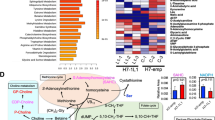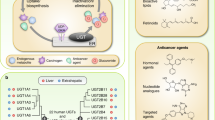Abstract
The UDP-glucuronosyltransferase UGT1A gene is a major biotransformation gene involved in the metabolism of a vast array of molecules. Recently, we uncovered a new series of alternative spliced isoforms referred to as isoforms 2 or UGT1As_i2 that use an alternative exon 5 (5b). The function of such mRNAs and the corresponding 45 kDa proteins still remains unclear. Although devoid of glucuronosyltransferase activity, UGT1As_i2 are widely co-expressed with the enzymatically active and classical UGT1A isoforms (UGT1As_i1). In this study, we observed abundant signal in human colon tissue samples, predominantly along intestinal crypts. In human cells, UGT1A_i2 proteins are expressed in similar subcellular compartments as UGT1As_i1. Cellular properties of i2-spliced forms were then studied using synthetic small-interfering RNA (siRNA) in two human colon cancer cell lines that show a significant amount of exon 5a- and exon 5b-containing mRNAs and that display enzymatic activities for UGT1As substrates. We observed that siRNA-mediated knockdown of endogenous i2 upregulates cellular glucuronidation activities by 120–170% (P<0.01) for all substrates tested. Functional data support a dominant-negative function for endogenous exon 5b-spliced forms of UGT1A, hence potentially affecting in vivo glucuronidation capacity. This new regulatory strategy may ensure an additional mean to modulate cellular response to endo/xeno stimulus.
This is a preview of subscription content, access via your institution
Access options
Subscribe to this journal
Receive 6 print issues and online access
$259.00 per year
only $43.17 per issue
Buy this article
- Purchase on Springer Link
- Instant access to full article PDF
Prices may be subject to local taxes which are calculated during checkout







Similar content being viewed by others
Abbreviations
- E2:
-
estradiol
- i1:
-
isoforms 1
- i2:
-
isoforms 2
- MPA:
-
mycophenolate acid
- PBS:
-
phosphate-buffered saline
- siRNA:
-
small-interfering RNA
- SN-38:
-
7-ethyl-10-hydroxycamptothecin
- UGT:
-
UDP-glucuronosyltransferase
References
Ritter JK . Intestinal UGTs as potential modifiers of pharmacokinetics and biological responses to drugs and xenobiotics. Expert Opin Drug Metab Toxicol 2007; 3: 93–107.
Ritter JK, Chen F, Sheen YY, Tran HM, Kimura S, Yeatman MT et al. A novel complex locus UGT1 encodes human bilirubin, phenol, and other UDP-glucuronosyltransferase isozymes with identical carboxyl termini. J Biol Chem 1992; 267: 3257–3261.
Gong QH, Cho JW, Huang T, Potter C, Gholami N, Basu NK et al. Thirteen UDPglucuronosyltransferase genes are encoded at the human UGT1 gene complex locus. Pharmacogenetics 2001; 11: 357–368.
Nagar S, Remmel RP . Uridine diphosphoglucuronosyltransferase pharmacogenetics and cancer. Oncogene 2006; 25: 1659–1672.
Guillemette C . Pharmacogenomics of human UDP-glucuronosyltransferase enzymes. Pharmacogenomics J 2003; 3: 136–158.
Girard H, Levesque E, Bellemare J, Journault K, Caillier B, Guillemette C . Genetic diversity at the UGT1 locus is amplified by a novel 3′ alternative splicing mechanism leading to nine additional UGT1A proteins that act as regulators of glucuronidation activity. Pharmacogenet Genomics 2007; 17: 1077–1089.
Levesque E, Girard H, Journault K, Lepine J, Guillemette C . Regulation of the UGT1A1 bilirubin-conjugating pathway: role of a new splicing event at the UGT1A locus. Hepatology 2007; 45: 128–138.
Albert C, Vallee M, Beaudry G, Belanger A, Hum DW . The monkey and human uridine diphosphate-glucuronosyltransferase UGT1A9, expressed in steroid target tissues, are estrogen-conjugating enzymes. Endocrinology 1999; 140: 3292–3302.
Pelletier G, Luu-The V, Labrie F . Immunocytochemical localization of type I 17 beta-hydroxysteroid dehydrogenase in the rat brain. Brain Res 1995; 704: 233–239.
Duguay Y, McGrath M, Lepine J, Gagne JF, Hankinson SE, Colditz GA et al. The functional UGT1A1 promoter polymorphism decreases endometrial cancer risk. Cancer Res 2004; 64: 1202–1207.
Bernard O, Guillemette C . The main role of UGT1A9 in the hepatic metabolism of mycophenolic acid and the effects of naturally occurring variants. Drug Metab Dispos 2004; 32: 775–778.
Gagne JF, Montminy V, Belanger P, Journault K, Gaucher G, Guillemette C . Common human UGT1A polymorphisms and the altered metabolism of irinotecan active metabolite 7-ethyl-10-hydroxycamptothecin (SN-38). Mol Pharmacol 2002; 62: 608–617.
Bosma PJ, Seppen J, Goldhoorn B, Bakker C, Oude Elferink RP, Chowdhury JR et al. Bilirubin UDP-glucuronosyltransferase 1 is the only relevant bilirubin glucuronidating isoform in man. J Biol Chem 1994; 269: 17960–17964.
Lepine J, Bernard O, Plante M, Tetu B, Pelletier G, Labrie F et al. Specificity and regioselectivity of the conjugation of estradiol, estrone, and their catecholestrogen and methoxyestrogen metabolites by human uridine diphospho-glucuronosyltransferases expressed in endometrium. J Clin Endocrinol Metab 2004; 89: 5222–5232.
Hanioka N, Ozawa S, Jinno H, Ando M, Saito Y, Sawada J . Human liver UDP-glucuronosyltransferase isoforms involved in the glucuronidation of 7-ethyl-10-hydroxycamptothecin. Xenobiotica 2001; 31: 687–699.
Meech R, Mackenzie PI . Structure and function of uridine diphosphate glucuronosyltransferases. Clin Exp Pharmacol Physiol 1997; 24: 907–915.
Ouzzine M, Magdalou J, Burchell B, Fournel-Gigleux S . Expression of a functionally active human hepatic UDP-glucuronosyltransferase (UGT1A6) lacking the N-terminal signal sequence in the endoplasmic reticulum. FEBS Lett 1999; 454: 187–191.
Radominska-Pandya A, Pokrovskaya ID, Xu J, Little JM, Jude AR, Kurten RC et al. Nuclear UDP-glucuronosyltransferases: identification of UGT2B7 and UGT1A6 in human liver nuclear membranes. Arch Biochem Biophys 2002; 399: 37–48.
Vanstapel F, Blanckaert N . Topology and regulation of bilirubin UDP-glucuronyltransferase in sealed native microsomes from rat liver. Arch Biochem Biophys 1988; 263: 216–225.
Wang ET, Sandberg R, Luo S, Khrebtukova I, Zhang L, Mayr C et al. Alternative isoform regulation in human tissue transcriptomes. Nature 2008; 456: 470–476.
Basu NK, Ciotti M, Hwang MS, Kole L, Mitra PS, Cho JW et al. Differential and special properties of the major human UGT1-encoded gastrointestinal UDP-glucuronosyltransferases enhance potential to control chemical uptake. J Biol Chem 2004; 279: 1429–1441.
Finel M, Kurkela M . The UDP-glucuronosyltransferases as oligomeric enzymes. Curr Drug Metab 2008; 9: 70–76.
Fujiwara R, Nakajima M, Oda S, Yamanaka H, Ikushiro SI, Sakaki T et al. Interactions between human UDP-glucuronosyltransferase (UGT) 2B7 and UGT1A enzymes. J Pharm Sci 2009. (e-pub ahead of print).
Ishii Y, Iwanaga M, Nishimura Y, Takeda S, Ikushiro S, Nagata K et al. Protein-protein interactions between rat hepatic cytochromes P450 (P450s) and UDP-glucuronosyltransferases (UGTs): evidence for the functionally active UGT in P450-UGT complex. Drug Metab Pharmacokinet 2007; 22: 367–376.
Dubey D, Ganesh S . Modulation of functional properties of laforin phosphatase by alternative splicing reveals a novel mechanism for the EPM2A gene in Lafora progressive myoclonus epilepsy. Hum Mol Genet 2008; 17: 3010–3020.
Sabatino L, Casamassimi A, Peluso G, Barone MV, Capaccio D, Migliore C et al. A novel peroxisome proliferator-activated receptor gamma isoform with dominant negative activity generated by alternative splicing. J Biol Chem 2005; 280: 26517–26525.
Bamberger CM, Bamberger AM, de Castro M, Chrousos GP . Glucocorticoid receptor beta, a potential endogenous inhibitor of glucocorticoid action in humans. J Clin Invest 1995; 95: 2435–2441.
Bedi R, Du J, Sharma AK, Gomes I, Ackerman SJ . Human C/EBP-epsilon activator and repressor isoforms differentially reprogram myeloid lineage commitment and differentiation. Blood 2009; 113: 317–327.
Gomes AR, Ferreira JS, Paternain AV, Lerma J, Duarte CB, Carvalho AL . Characterization of alternatively spliced isoforms of AMPA receptor subunits encoding truncated receptors. Mol Cell Neurosci 2008; 37: 323–334.
Acknowledgements
We thank Patrick Caron and Lyne Villeneuve for technical assistance. We are thankful to Michèle Orain for colon tissue preparation samples, to Dr Georges Pelletier, Johanne Ouellet and Marie-Odile Benoit-Biancamano for scientific advices for immunohistochemistry experiments. This work was supported by the Canadian Institutes of Health Research (CIHR MOP-88745) and the Canada Research Chair Program (CG). JB and MR are recipients of a CIHR Frederick Banting and Charles Best studentship award and a graduate studentship award from the Fonds de la recherche en santé du Québec (FRSQ), respectively. CG holds a Canada Research Chair in Pharmacogenomics.
Author information
Authors and Affiliations
Corresponding author
Ethics declarations
Competing interests
The authors declare no conflict of interest.
Additional information
Supplementary Information accompanies the paper on the The Pharmacogenomics Journal website
Supplementary information
Rights and permissions
About this article
Cite this article
Bellemare, J., Rouleau, M., Harvey, M. et al. Alternative-splicing forms of the major phase II conjugating UGT1A gene negatively regulate glucuronidation in human carcinoma cell lines. Pharmacogenomics J 10, 431–441 (2010). https://doi.org/10.1038/tpj.2009.64
Received:
Revised:
Accepted:
Published:
Issue Date:
DOI: https://doi.org/10.1038/tpj.2009.64



